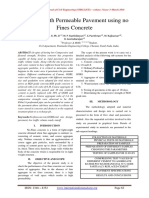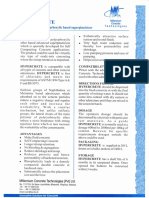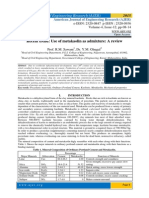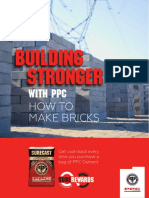Dry Mix Conc Proposal
Dry Mix Conc Proposal
Uploaded by
nishat meghnaCopyright:
Available Formats
Dry Mix Conc Proposal
Dry Mix Conc Proposal
Uploaded by
nishat meghnaCopyright
Available Formats
Share this document
Did you find this document useful?
Is this content inappropriate?
Copyright:
Available Formats
Dry Mix Conc Proposal
Dry Mix Conc Proposal
Uploaded by
nishat meghnaCopyright:
Available Formats
PROPOSAL
1. TITLE
Dry mix concrete.
2. BACKGROUND
Ready mix concrete is becoming famous worldwide day by day. Generally, ready mix concrete
combines a precise amount of gravel, sand, water and cement together by weight allowing concrete
mixtures to be developed and implemented on construction sites. Concrete has limited time and
should be used within 210 minutes of batching the plant as water is mixed in the mixture.If there
occurs any delay while using the ready mix concrete, the acceleration stage of hydration starts and
the strength is reduced. So, in this case different types of admixtures are used to reduce water
requirements and entrain air in the mixture. But in dry mis concrete, all the materials are mixed
beforehand without using water. Water is used in the site when it’s needed. If there occurs any
inconvenience in the travel time or any other difficulties occur, as there exists no water in dry mix
concrete, there is no scope of hydration in the mixture.
3. SIGNIFICANCE
There are some significance of dry mix concrete. They are stated below-
The compound is mixed with water just before use creates two important degrees of
freedom, namely the setting time and the compressive strength or the development thereof.
High strength mix is achieved just in few minutes.
No need to rush to different vendors for purchasing the materials separately.
Transportation cost requires for different materials to transport is eliminated.
Adulteration in materials is reduced.
Faster completion of work.
Labor cost reduced to some extent.
Finely graded materials.
Just in time production eliminates dependence on the weather and other adverse condition.
4. METHODOLOGY
The dry mix design involves three important steps, e.g., selection of aggregates, aggregates
gradation, and proportion of aggregates.The desirable qualities of a mixture are dependent to a
considerable degree on the nature of the aggregates used. Aggregates are classified as coarse, fine,
and filler. The function of the coarse aggregates in contributing to the stability of a mixture is
largely due to interlocking and frictional resistance of adjacent particles. Similarly, fines or sand
contributes to stability failure function in filling the voids between coarse aggregates. Crushed
aggregates and sharp sands produce higher stability of the mix when compared with gravel and
rounded sand.The properties of the mix including the density and stability are very much dependent
on the aggregates and their grain size distribution. Gradation has a profound effect on mix
performance. It might be reasonable to believe that the best gradation is one that produces
maximum density. This would involve a particle arrangement where smaller particles are packed
between larger particles, thus reducing the void space between particles. This create more particle-
to-particle contact, which would increase stability and reduce water infiltration. However, some
minimum amount of void space is necessary to:
provide adequate volume for the binder to occupy,
promote rapid drainage, and
provide resistance to frost action for base and sub base courses.
After selecting the aggregates and their gradation, proportioning of aggregates has to be done and
following are the common methods of proportioning of aggregates:
Trial and error procedure: Vary the proportion of materials until the required aggregate
gradation is achieved.
Graphical Methods: Two graphical methods in common use for proportioning of
aggregates are, Triangular chart method and Roch’s method. The former is used when only
three materials are to be mixed.
Analytical Method: In this method a system of equations are developed based on the
gradation of each aggregates, required gradation, and solved by numerical methods. The
resulting solution gives the proportion of each type of material required for the given
aggregate gradation.
5. PACKAGING
PolyEthelene Packaging can be used for dry mix concrete. Polyethelene bags have some
benefits in this case-
Rainproof
Tear resistant
Can be stored outdoors
Recyclable and biodegradable
No product leakage
Can be stored outdoors
Moisture resistant- product stays fresher for longer time
Easier to stack
6. POSSIBLE OUTCOME
In conclusion, we may suggest that dry mix concrete will enable the concrete industry to overcome
the loss of time in site as the mixture is prepared while packaging and labors have to just add water
in the site.Moreover, it reduces transportation cost and has many other advantages.
You might also like
- Pipe Culvert Drawing PDFDocument1 pagePipe Culvert Drawing PDFPramesh Kori100% (4)
- Stabilized Mud BlockDocument31 pagesStabilized Mud BlockRenuka Talwar100% (3)
- Water ProofingDocument3 pagesWater ProofingmichaelNo ratings yet
- GFRCDocument4 pagesGFRCrahulchandokNo ratings yet
- Code of Practise Surface Water Drainage Oct2004 PDFDocument57 pagesCode of Practise Surface Water Drainage Oct2004 PDFMelinda GordonNo ratings yet
- Cement Dry Mix - Ready ReckonerDocument3 pagesCement Dry Mix - Ready ReckonerMoe KimoNo ratings yet
- Special ConcreteDocument2 pagesSpecial ConcreteRamprasad KadaliNo ratings yet
- TDS Screed 200-10F160807Document1 pageTDS Screed 200-10F160807Sean PnyktNo ratings yet
- Aci 211 Design MixDocument19 pagesAci 211 Design MixJAZPAKNo ratings yet
- Millennium Product DataDocument15 pagesMillennium Product DataAnonymous ZizCrNlQkpNo ratings yet
- Nitoflor SL2050: Constructive SolutionsDocument4 pagesNitoflor SL2050: Constructive SolutionsNishant VasuNo ratings yet
- Standards PDFDocument10 pagesStandards PDFbadrudinNo ratings yet
- Abrasion ResistanceDocument5 pagesAbrasion ResistanceHafiz Zain AkramNo ratings yet
- Introduction of Cement: When Was Cement Begin?Document11 pagesIntroduction of Cement: When Was Cement Begin?مايف سعدونNo ratings yet
- Admixtures For The Drymix Industry: Where Powder Meets PowerDocument44 pagesAdmixtures For The Drymix Industry: Where Powder Meets PowerBala100% (1)
- No Fines ConcreteDocument5 pagesNo Fines ConcretedannyNo ratings yet
- Is Concrete Mix DesignDocument21 pagesIs Concrete Mix DesignahmedanyNo ratings yet
- Pull-Off Test Report - PUB Pedestrian Bridge ProjectDocument1 pagePull-Off Test Report - PUB Pedestrian Bridge ProjectErin Williams100% (1)
- Shrinkage Compensating Admixtures by Sunanda CoatingsDocument2 pagesShrinkage Compensating Admixtures by Sunanda Coatingss.skumar10% (1)
- Mix Design Foam ConcreteDocument13 pagesMix Design Foam ConcreteVirga PriyoNo ratings yet
- Astm C31 C31M 24Document6 pagesAstm C31 C31M 24Carlos LovoNo ratings yet
- High Performance Premium Tile AdhesivesDocument6 pagesHigh Performance Premium Tile Adhesivesshreekumar_scdlNo ratings yet
- TDS Pidicryl 326N PureDocument2 pagesTDS Pidicryl 326N PureLaura Isabel RodriguezNo ratings yet
- Cement Additives (Function and Definition)Document3 pagesCement Additives (Function and Definition)Yougchu LuanNo ratings yet
- Crystalline Coating and Its Influence On The WaterDocument8 pagesCrystalline Coating and Its Influence On The WaterRiza SuwondoNo ratings yet
- Castech Rel WB Technical Data Sheet: Description Shelf LifeDocument2 pagesCastech Rel WB Technical Data Sheet: Description Shelf LifeDileepa DissanayakeNo ratings yet
- Test Report of MetakaolinDocument14 pagesTest Report of MetakaolinAbdul Falahitawan UfalNo ratings yet
- Case Study of Permeability-Reducing Admixture Use in Anti-Flotation Slabs: Building in Brasilia, BrazilDocument9 pagesCase Study of Permeability-Reducing Admixture Use in Anti-Flotation Slabs: Building in Brasilia, BrazilCarlos Augusto Sánchez Rondón100% (1)
- Autoclave Aerated ConcreteDocument3 pagesAutoclave Aerated ConcreteFireSwarmNo ratings yet
- Concrete Admixture Product Information SheetDocument3 pagesConcrete Admixture Product Information SheetTeodor BaniskiNo ratings yet
- Concrete in Hot Weather Conditions-Challanges - Precautions: Dr. S. Vijaya Mohan RaoDocument6 pagesConcrete in Hot Weather Conditions-Challanges - Precautions: Dr. S. Vijaya Mohan RaoHussain ElarabiNo ratings yet
- Liquid Applied Waterproofing - ProtectowrapDocument3 pagesLiquid Applied Waterproofing - ProtectowrapYndia SorianoNo ratings yet
- RamsetDocument1 pageRamsetbradleyrobinsonNo ratings yet
- Admixtures 2Document18 pagesAdmixtures 2stephanyNo ratings yet
- 09 - TDS - Masterflow 928T PDFDocument5 pages09 - TDS - Masterflow 928T PDFGibbs PerNo ratings yet
- Chryso Fluid Premia 150: DescriptionDocument2 pagesChryso Fluid Premia 150: DescriptionNidDouNo ratings yet
- Wall Putty-Product ProfileDocument17 pagesWall Putty-Product ProfileVetri Vel Prakash100% (1)
- Green Concrete PresentationDocument17 pagesGreen Concrete PresentationSivaramakrishnan PNo ratings yet
- Hyper CreteDocument2 pagesHyper CretedjgiumixNo ratings yet
- Partial Replacement of Cement To Concrete by Marble Dust PowderDocument12 pagesPartial Replacement of Cement To Concrete by Marble Dust PowderIJMTST-Online JournalNo ratings yet
- Dinesh Chandran K.P, Head - Technical Services and R&D Ultratech Cement Limited, Building Products Division, MumbaiDocument7 pagesDinesh Chandran K.P, Head - Technical Services and R&D Ultratech Cement Limited, Building Products Division, MumbaiRabish ANo ratings yet
- TDS - Flowcable 50Document2 pagesTDS - Flowcable 50Venkata RaoNo ratings yet
- Metakaolin-Pozzolanic Material For Cement in High Strength ConcreteDocument4 pagesMetakaolin-Pozzolanic Material For Cement in High Strength ConcreteElango PaulchamyNo ratings yet
- MS 14 - Internal Waterproofing PDFDocument3 pagesMS 14 - Internal Waterproofing PDFsullamsNo ratings yet
- A Review Paper On Replacement of Fine AggregateDocument5 pagesA Review Paper On Replacement of Fine AggregateIJRASETPublicationsNo ratings yet
- Recent Trend: Use of Metakaolin As Admixture: A ReviewDocument7 pagesRecent Trend: Use of Metakaolin As Admixture: A ReviewAJER JOURNALNo ratings yet
- Self Curing PDFDocument26 pagesSelf Curing PDFlingarajNo ratings yet
- Saveto Concrete Repair Guide - Concrete Repair Guide 2017 - en - 53 PDFDocument2 pagesSaveto Concrete Repair Guide - Concrete Repair Guide 2017 - en - 53 PDFBadhur ZamanNo ratings yet
- Towards Sustainable ConcreteDocument2 pagesTowards Sustainable ConcreteJouber FerreiraNo ratings yet
- Session 3 AdmixturesDocument40 pagesSession 3 Admixturesimsrinivash1100% (1)
- BASF MasterGlenium 3889 - SuperplasticizerDocument2 pagesBASF MasterGlenium 3889 - SuperplasticizerHJ100% (2)
- Comparative Study of Different Calcined Waste Shells As Partial Replacement To Cement in MortarDocument1 pageComparative Study of Different Calcined Waste Shells As Partial Replacement To Cement in MortarBillie Ian B. Salamante Jr.No ratings yet
- Sand TestDocument24 pagesSand TestBai Alleha MusaNo ratings yet
- Delta Foam Generator, Foaming Agent BrochuresDocument4 pagesDelta Foam Generator, Foaming Agent BrochureslemariparaNo ratings yet
- Viscoflux-Hd: Polycarboxylate Ether For Concrete AdmixturesDocument5 pagesViscoflux-Hd: Polycarboxylate Ether For Concrete AdmixturesBhagwat PatilNo ratings yet
- Cement & Concrete Composites: Shiho Kawashima, Surendra P. ShahDocument8 pagesCement & Concrete Composites: Shiho Kawashima, Surendra P. ShahratnasaiNo ratings yet
- ConcreteDocument5 pagesConcreteujcivil99No ratings yet
- ConcreteDocument12 pagesConcreteAbhinavNo ratings yet
- Concrete Technology Assignment 1Document18 pagesConcrete Technology Assignment 1Boiki RabewuNo ratings yet
- A Simple and Effective Method of Repairing Potholes in IndiaDocument46 pagesA Simple and Effective Method of Repairing Potholes in IndiaProf. Prithvi Singh Kandhal100% (4)
- Use of Waste Plastic in Road ConstructionDocument33 pagesUse of Waste Plastic in Road ConstructionShruti SinghalNo ratings yet
- Concrete Proportion and Concrete MixtureDocument12 pagesConcrete Proportion and Concrete MixtureEnrico luis EscobarNo ratings yet
- B15 Intro RC Detailing Presentation PDFDocument46 pagesB15 Intro RC Detailing Presentation PDFGabriel Broasca0% (1)
- BS en 13230-6-2020 - (2023-05-31 - 08-25-53 PM)Document64 pagesBS en 13230-6-2020 - (2023-05-31 - 08-25-53 PM)Alireza MashhadizadehNo ratings yet
- International Standards For Tubing - PetroWiki PDFDocument6 pagesInternational Standards For Tubing - PetroWiki PDFLuis David Concha CastilloNo ratings yet
- Waterproofing Solutions For Underground ConstructionDocument8 pagesWaterproofing Solutions For Underground ConstructionMumtazNo ratings yet
- Engineering Structures: Stefano Sorace, Gloria TerenziDocument13 pagesEngineering Structures: Stefano Sorace, Gloria TerenzipaulkohanNo ratings yet
- HVAC Interview TestDocument5 pagesHVAC Interview TestIsmael PerezNo ratings yet
- RTHD - 5 - SASEC Road Connectivity ProjectDocument3 pagesRTHD - 5 - SASEC Road Connectivity ProjectsorowareNo ratings yet
- ArmaSoundRD 240 ESDocument4 pagesArmaSoundRD 240 ESSuthi Sae DanNo ratings yet
- Stability of Slopes and Earth DamsDocument11 pagesStability of Slopes and Earth DamsMOSHITOMOSHITANo ratings yet
- Erd of Bridges and Concrete Dams: Dr. Saurabh ShiradhonkarDocument66 pagesErd of Bridges and Concrete Dams: Dr. Saurabh ShiradhonkarAnubhav ChaudharyNo ratings yet
- Diamite PDFDocument1 pageDiamite PDFGuntherNo ratings yet
- Unit 1 IarDocument78 pagesUnit 1 IarAshish SharmaNo ratings yet
- Multisplit Octubre 2021Document1 pageMultisplit Octubre 2021AbdelNo ratings yet
- Types of Failures in Rigid Pavements: Presented By, AglaiaDocument40 pagesTypes of Failures in Rigid Pavements: Presented By, AglaiaLokesh KNo ratings yet
- Stability of ColumnsDocument13 pagesStability of ColumnssivaNo ratings yet
- Specification - Civil Design CriteriaDocument8 pagesSpecification - Civil Design CriteriaAzhar AliNo ratings yet
- The Frame Is The Core To The Bicycle As A Complete Functional UnitDocument2 pagesThe Frame Is The Core To The Bicycle As A Complete Functional UnitAbood AtiyatNo ratings yet
- Agas-Agas Bridge: The Tallest Bridge in The PhilippinesDocument53 pagesAgas-Agas Bridge: The Tallest Bridge in The PhilippinesGiro Gonzales0% (1)
- F D C & V R: Lexible Uct Onnector Ane AilDocument4 pagesF D C & V R: Lexible Uct Onnector Ane Ailsharath_boga9515No ratings yet
- Field Engineers Course - Highway Maintenance MethodsDocument264 pagesField Engineers Course - Highway Maintenance MethodsEvaresto Cole MalonesNo ratings yet
- Venturi MeterDocument8 pagesVenturi MeterSwati SachanNo ratings yet
- Ckki4hy8006990qmh6nqy3b4c PPC Guide How To Make BricksDocument7 pagesCkki4hy8006990qmh6nqy3b4c PPC Guide How To Make BricksMKG MKGNo ratings yet
- An 823 An 816Document1 pageAn 823 An 816blackhawkNo ratings yet
- Solution To AssignmentsDocument7 pagesSolution To AssignmentsMayank ShrivastavaNo ratings yet
- Nashik Sinnar Drawing by SP 7 Aug 21Document1 pageNashik Sinnar Drawing by SP 7 Aug 21Suresh patilNo ratings yet
- No of Stone ColumnsDocument5 pagesNo of Stone Columnsknight1729100% (1)
- Acel Rate 2014Document8 pagesAcel Rate 2014Genevieve Gayoso0% (1)

























































































